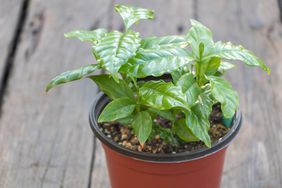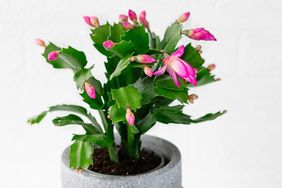Thanks to its colorful flowers that bloom in winter, the Christmas cactus (Schlumbergera x buckleyi) has become a cheery addition to many homes during the holiday season. Though cacti are often associated with arid, desert-like conditions, the Christmas cactus originated in the tropical rainforests of Southeastern Brazil, and prefers more humid environments than other cacti. With the correct conditions and care, you can keep this merry houseplant alive and blooming for years (and more holidays) to come.
What Is a Christmas Cactus?
There are three types of holiday cacti: Christmas, Thanksgiving, and Easter. Each type of cactus blooms around the holiday it's named after. Christmas cacti have hanging branches composed of flat green leaves and rounded teeth. They produce red, pink, white, or purple flowers that bloom at the ends of these branches (which may reach up to 3 feet). Each flower—which is typically about 3 inches long—lasts for several days, though the entire flowering period typically spans about two weeks.
:max_bytes(150000):strip_icc()/how-to-care-for-your-christmas-cactus-0822-2000-a3407f3e2abe4eee8e93bcec557e65f4.jpg)
How to Care for a Christmas Cactus
Christmas cacti are relatively easy to grow, says Tanner Allen, horticulturist and product development manager at Westerlay Orchids, so long as you understand their basic needs.
Light
The Christmas cactus has very specific lighting needs when it comes to blooming. For best results, place the plant near a window where it receives bright, indirect light. The light should be filtered so you don't risk causing discoloration.
Soil
Like many other plants in the cactus family, these blooming beauties do not like to have "wet feet," which is why you want to make sure you're using a soil that is well-draining. A mix that is specifically designed for succulents and cacti is ideal, says Allen.
Water
This species doesn't like to be quite as dry as some of its more arid cousins. Water when the top third of the soil feels dry, but reduce watering in the fall to initiate flowering.
Fertilizer
If you want to give your Christmas cactus a boost, you can do so using any general liquid or granular fertilizer with a balanced NPK (nitrogen, phosphorus, and potassium) ratio. "Apply during the growing season, generally spring and summer," says Allen. Fertilize your Christmas cactus every two weeks during the active growth period.
Temperature
While these plants tend to put on their best show in the winter, they don't like to get too chilly. Christmas cactus prefers temperatures that range between 60 and 70 degrees Fahrenheit, but it can tolerate temperatures as low as 50 degrees. And if your home is particularly dry, place a shallow bowl of water nearby to help humidify the air—Christmas cacti like it balmy.
How to Prune Christmas Cactus
Christmas cactus doesn't typically require pruning, unless you want to keep your plant smaller. "To prune, just twist off or clip off where two stem segments connect," says Justin Hancock of Costa Farms. "The best time to do this is right after the plant finishes blooming, usually January or February."
How to Get Christmas Cactus to Rebloom
In order for those stunning flowers to appear, your cactus needs the right conditions. This includes short days and long, dark nights. Six to eight weeks before Christmas, place your cactus in a completely dark area (like the garage or basement, where house lights won't be on) for 12 hours each night—then carry it to a sunny spot to expose it to 10 hours of daylight.
If, for some reason, buds don't form, move your plant closer to a window, as this is your plant's way of telling you that its daytime light isn't bright enough, says Christopher Satch, plant scientist at New York-based houseplant oasis The Sill.
How to Overwinter Christmas Cactus
Christmas cactus is hardy in zones 10 to 11 and should be overwintered in areas where they're not hardy. Bring your plant indoors when temperatures drop below 50 degrees to keep it protected during colder weather.
:max_bytes(150000):strip_icc()/christmas-cactus-1113-6db8fd137c5d4c90a36ffb66211e3646.jpg)
Rosemary Calvert/Getty Images
How to Propagate a Christmas Cactus
Christmas cacti are very easy to propagate, which is best done during the spring. "If you wish to take cuttings to share, ensure the piece(s) you break off have at least two or three segments," says Hancock.
- Clip a piece of cactus with two to three segments.
- Let the segments sit for a day or two.
- Fill a pot with cacti and succulent mix.
- Make a hole in your soil and place the clipping in the hole.
- Keep the pot in a warm, bright place, keeping the soil moist. In a few weeks, they should root and start to put out new growth.
Common Problems With Christmas Cactus
While Christmas cactus is known for being low maintenance, there are a few problems you may encounter when caring for the houseplant.
Fungal Disease
Fungal diseases may occur and often appear as yellow, brown, or black spots on the stems. "These diseases are most commonly associated with the plant being kept too moist, in insufficient light, or in a room with poor airflow," says Hancock. "If your plant is showing spotting of the stems, try providing more light if possible (such as placing an LED lamp over the plant to augment natural light) and ensure it’s not being overwatered."
Mealybugs
Mealybugs can be a major nuisance for this plant. "Mealybugs can suck the nutrients from Christmas cactus and produce a sugary substance called honeydew, which can lead to an increase of ants inside the home that target the plant," says Zackary DeAngelis, CEO and founder of Pest Pointers LLC. "Plus, the production of honeydew can lead to sooty mold on your Christmas cactus, which leaves a black, unsightly residue on the plant over time."
To avoid mealybugs, routinely check your Christmas cactus for signs of infestation. "Mealybugs can be identified by their powdered wax outer layer," DeAngelis says. Treat mealybugs with an insecticidal soap spray, which will help to control and eliminate the insects on contact.
Root Rot
Root rot, which is when the roots suffocate, die, and rot, can occur if the plant is overwatered. "The easiest way to prevent root rot is to feel the potting mix before watering to ensure it needs moisture and you’re not adding too much water," says Hancock. "If your plant is suffering from root rot, helping the soil get back to optimal moisture levels is key."














